Ten Reasons Why We Need a New Nature Movement
Junior Rangers in the Prealpi Giulie Nature Park © Leonardo Cerno
By Richard Louv
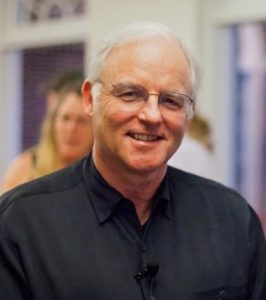
Richard Louv
Richard Louv is a bestselling author who sparked an international debate and movement to reconnect kids and nature, through his book Last Child in the Woods. He coined the term nature-deficit disorder which has influenced policy and inspired campaigns across North America.
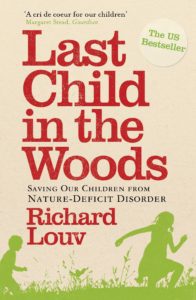
Richard Louv LAst Child in the Woods
Climate change, biodiversity collapse, and the disconnect of children from nature are the greatest environmental challenges of our time — and all are interrelated.
The Nature-deficit disorder
In recent decades, children and adults around the world have become increasingly disconnected from nature, with profound implications for human health and child development – with indicated impacts on attention disorders, Vitamin D deficiency, myopia, childhood obesity and the growing epidemics of both inactivity and loneliness.
The great work of the remainder of the 21st Century will be the development of a new and positive relationship between human beings and the rest of the natural world.
When I wrote “Last Child in the Woods” about what I called nature-deficit disorder (not a known medical diagnosis, though perhaps it should be), I cited about 60 studies. The topic of the influence of the natural world on human development was, to say the least, understudied. Today, over 800 studies are abstracted in the Children & Nature Network’s research library, which is available to anyone in the world.
Specific to the nature-deficit disorder, five major barriers stand between humans, especially children, and the rest of the natural world.
- Urbanisation without nature.
- A media and politics-driven culture of Fear
- Digital dominance of our lives.
- Cultural and educational devaluing of the natural world
- The Dystopian Trance: a post-apocalyptic view of the future.
The good news is that attitudes about the nature connection are changing – not fast enough – but we now see pediatricians in the U.S. writing prescriptions for nature; we see a 500% increase in the number of nature preschools; family nature clubs spreading all over; and we see an international movement growing around the world.
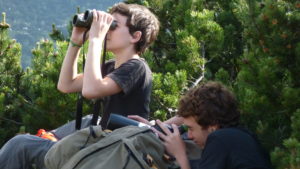
Ten Reasons Why We Need a New Nature Movement
1) As of 2008, more than half of the world’s population lives in towns and cities. This transformation will produce one of two outcomes: either the end of meaningful daily experience in nature, or the beginning of a new kind of city – and a new view of our role in and our definition of nature.
2) Adults have nature-deficit disorder, too. The children and nature movement will not succeed unless adults come to see the importance of our own connection to the natural world.
3) Environmentalism needs to hit reset. Environmental concern, in some areas, has dropped to its lowest point since before Earth Day 1970. Why? Economic recession. A well-financed campaign of disinformation. An inability to describe a great future. For whatever reason, environmentalism remains a pup tent. We need a bigger tent. In fact, we need a river.
4) Sustainability alone is not sustainable. Though we don’t have a better word to replace it, the word sustainsuggests stasis. We need more than stasis; we need to produce human energy (health, intelligence, creativity, joy) through nature.
5) Conservation is not enough. Now we need to “create” nature. Even if we conserve every square foot of remaining wilderness, and we should, it won’t be enough to guarantee the biodiverse habitats that humans and other organisms will require to thrive. In addition to conservation, we must now restore or create natural habitats on our farms and ranches, in our cities, neighborhoods, commercial buildings, yards, and on our roofs. We’ll need the true greening of the urban world.
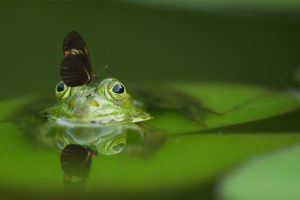
pixabay
6) The more high-tech we become, the more nature we need. We hear talk of a “post-biological” era in which human beings are optimally enhanced by technology. Yet, we’ve only begun to study how the natural world can optimize human health and intelligence. Technology will always be with us, but as it grows, we’ll need an antidote to its downside.
7) The Development of Hybrid Minds, ones capable of the ultimate multitasking: to live simultaneously in both the digital and physical worlds, using computers to maximize our powers to process intellectual data and natural environments to ignite our senses and accelerate our ability to learn and feel.
8) A New Nature Movement will create new jobs. Connecting nature experience directly to human health and cognitive abilities will need nature preschool teachers, physicians and therapists who specialise in the healing power of nature; biophilic architects, landscapers and city planners to start using native plants to increase biodiversity; park rangers to take on the additional role of health para-professional – and many more.
9) Connecting children to nature brings unlikely allies together. Conservatives, liberals, business people, environmentalists, teachers, pediatricians, and people of different religions will sit down at the same table.
10) We hunger for a positive image of the future. If we see only an apocalyptic future, that’s what we’ll get, or close to it. But imagine a society in which our lives become as immersed in nature as they are in technology, every day, where we live, work, learn and play. Imagine a future in which our intelligence and creativity, our ability to feel and be fully alive is enhanced by more frequent contact with the natural world.
You found this topic interesting? To find more articles like this one, download the new edition of the EUROPARC Journal Protected Areas In-Sight with a special focus on youth involvement Parks – available in english, german and french!
Siggen Seminar 2019!
Youth+ Jumpers just hanging around - a rare moment. Photo by Laura Peters
Youth involvement in Protected Areas
Siggen Seminar 2019 18th – 21st March, Gut Siggen, Germany
Are you looking for ideas and solutions to better engage young people within your park? Do you have case studies and good practices you would like to share with other managers from across Europe? This year, continuing on from the launch of the Youth Manifesto, EUROPARC is organising the two-day seminar for members, specifically focused on working with youth.
Young people are the future of Protected Areas in Europe! But trying to get young people interested in the environment can be difficult as it involves changing perceptions and attitudes – something that requires a lot of time and effort.
The seminar is FREE for members of the EUROPARC Federation (meals and accommodation included). Participants will therefore ONLY cover their own travel to and from the event.
Registrations are now closed!
The seminar will include practical activities and opportunities for exchanging knowledge
You will have a chance to see case studies from across Europe. Here are some of the topics we will be considering:
- What are the needs and expectations of youth living within protected areas across Europe?
- What challenges protected areas are currently facing when engaging young people?
- Which opportunities and solutions PA’s can offer to youth?
- We will introduce and work on the new Youth + programme which can be a model for working with 18-25 year olds in your park.
- We will look at the Youth Manifesto, considering how to encourage more PAs to implement it into their work.
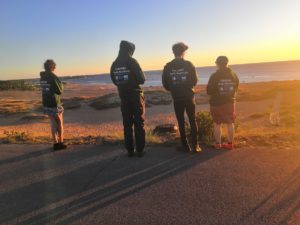
EUROPARC Youth Manifesto – Workshop II in Kalajoki, Finland June 2018 (©Rita Kovács)
We will also share different perspectives, taking a look at other youth programmes, and helping you build a programme in your area. Among others, you will see:
- An educational program for sustainability: Cairngorms National Park (UK)
- The national Junior Ranger program in Estonia
- The Youth Advisory Board in Prealpi Giulie Natural Park (IT)
- A new vision for the engagement of young people in a periurban park (E)
You are welcome to bring your own ideas for a collective “surgery” where we can examine problems and challenges you may have and suggest solutions together.
The goal of the Siggen Seminar
Protected Area professionals learning together, sharing experiences and knowledge in differing aspects of Protected Area management, and bringing innovative ideas to the table – that is exactly what EUROPARC Federation wants to achieve with Siggen Seminar.
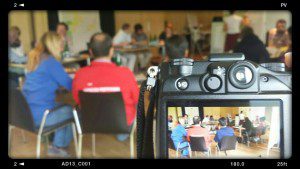
Training Seminar © EUROPARC Federation
With the enlightened generosity of the Alfred Toepfer Stiftung F.V.S., we will have the access to the private seminar centre at Gut Siggen in North Germany, hugging the Baltic Sea coast.
There are still few seats available, and they are free of charge! So don’t miss the opportunity to exchange knowledge, share experience, and establish professional contacts! Those are the most beneficial elements for working in the international context of conservation. The knowledge that you can gain in Siggen feeds back into your work in the different regions of Europe and fosters your sense of connectedness and togetherness in the EUROPARC Federation.
How to get to the Siggen Seminar Center?
The Siggen Seminar Center belongs to the Alfred Toepfer Foundation and lies on the north-eastern coast of Germany in the county of Holstein. It is a 20-minute taxi ride from the nearest train station, Oldenburg (Holst), and a five-minute bike-ride to the nearest beach.
Please contact EUROPARC with any questions you might have and download the pdf Directions to Siggen to learn how you can easily reach it by plane, train or car.
“Building the next generation of Nature Conservationists”
Hendrikus_van_Hensbergen
An outdoor talk with Hendrickus van Hensbergen
How often do you meet entrepreneurs making a change for nature?
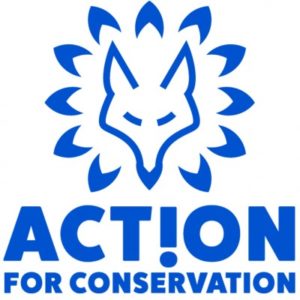
Action for conservation logo
Hendrickus van Hensbergen was an invited speaker at the EUROPARC Conference 2018 and we could not miss the opportunity to talk to him in person. Founder and Chief Executive Officer of the charity “Action for Conservation”, Hendrikus is not only a young entrepreneur working for conservation – he is inspiring other youngsters to lead the change.
Despite his Dutch name, Hendrikus grew up sharing his time between the UK’s South-West Jurassic Coast and the Guadarrama Mountains in Spain. “As a child, I remember collecting vulture feathers and catching lizards”, revealed Hendrikus with sparkling eyes. Growing up in such iconic landscapes has certainly shaped his character and triggered his career choices – his passion for nature led him down a path into zoology and conservation. Now, he spends his time engaging with youngsters in schools and camps, enabling them to connect to nature. As he explained, “by 2030, 92,2% of the UK’s population will be living in cities, so we need to think about ways to get young people out to enjoy natural spaces, otherwise they won’t value or care for them”.
EUROPARC Federation (E): What made you start the charity “Action for Conservation”?
Hendrikus (H): In my previous job at WWF, I had the chance to visit my old secondary school. I went with some quite lazy assumptions about young people and how they would engage with environmental issues – in my case, I was not really aware of them until late into my teens. Also, the image presented by the press about young teens is quite negative: addicted to technology, disengaged, disinterested… but I found completely the opposite.
They were really inspiring and keen to learn and that sparked something in me. What if we could harness the energy and ideas of young people? Particularly in England and Wales, there are very few approaches that really target teenagers – it was a bit of a niche, a gap that was not being filled.
Understanding this made me join forces with fellow young conservationists. We started out as a project going to schools to speak to young people from different backgrounds. And that’s really how the charity began, just as a network of young people interested in engaging other young people in environmental issues.
(E) How are you engaging young people?
(H) We believe that all young people should feel moved and empowered to protect the natural world and so we developed three programmes for youngsters. The main one, which also reaches a broader audience, is developed in secondary schools, particularly in disadvantaged urban areas. The second programme is our residential camp, which is a much more immersive experience, taking place in national parks, where we bring young people to spend time together and connect with nature. Lastly, we have an ambassador programme, which is a year-long programme to mentor and support young individuals taking action in their communities.
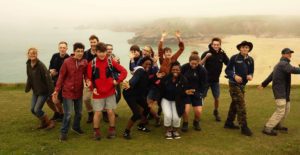
Photo with the courtesy of Action for Conservation
(E) Can you tell us more about the programme with secondary schools?
(H) Our schools’ work is focused on engaging a wide spectrum of society. The aim is to inspire the youngsters and support them in designing and delivering their own projects so they can have a real impact in their community and feel a sense of success.
We would go into three workshops with the same group of students, over a school term. The 1st workshop is all about inspiration, it’s very active as we are building knowledge and interest levels. In the next workshops, we support them in designing and implementing their projects, which they present back in the end. If they were successful, they go through a final event with several schools, where they share their achievements.
(E) This means that the students, in the end, are making a real contribution in their communities…?
(H) Yes, we try to focus on local issues and partner as much as possible with other conservation organisations working locally, so that young people can have meaningful action and impact. Addressing something place-based, which is relevant for their area and community, is essential. If you are not connected with your local place, then it is hard to be connected to anything else.
(EU) What have you learned on the way?
(H) I have learned how to fundraise, which is very challenging – there are limited pots of money and typically, funds in the UK have been quite focused on particular areas – it might be children and young people, it might be environment, and they would not necessary fund things that sit at the intersection between these two. To start the Charity, for example, we had to find an alternative solution and made it through a crowd-funding campaign.
There are also a lot of challenges around working with schools. Teachers are under a lot of pressure and have in average 8 seconds to read an email, so you really have to be quite sharp on how to get teachers on board and get their interest.
Working with young people is amazing but can be challenging. We work with theatre professionals to make our workshops more interactive and not rely on boring PowerPoints – that’s how what we do sticks with them.
(E) What would be your 3 pieces of advice for Young people?
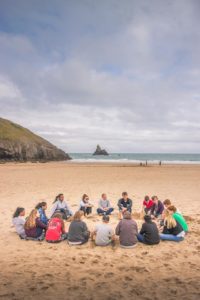
Photo with the courtesy of Action for Conservation
(H) First, find your passion and hold on to it, it does not necessarily have to be conservation. Following your passion is not easy – it might not always mean money or a certain life style, but it will give you fulfilment!
Second, take action. If you feel like something needs to change and there is no mechanism to change it through other organisations or normal routes, you need to take the risk and take action. That is in essence what happened with the charity. I started a project to fulfil a need, to fill a gap, and everything kind of evolved out of that.
Third, build a community around you – they will be your support and will make things happen. But be willing to work really hard! Built up slowly and steadily, because it will give you a stronger base and thus, will be more likely to work. Take things slowly, let them evolve naturally.
(E) So far, you have mainly been working with national parks in England and Wales. How do you see a future cooperation with EUROPARC and other European Protected Areas?
(H) We are keen to work with organisations to put young people at the centre of decision-making – it is the only way they will feel empowered for protected areas to become a part of their identity. We see ourselves as facilitators: what we have is a layered model that is effective and can be adapted to different contexts across Europe. I have been taking it to other places, and I would be very interested in doing it also with other EUROPARC members.
Watch EUROPARC Live Video with Hendrickus’ full interview!
For more information visit http://www.actionforconservation.org/
You found this topic interesting? To find more articles like this one, download the new edition of the EUROPARC Journal Protected Areas In-Sight with a special focus on youth involvement Parks – available in english, german and french!
2019 Tourism for Tomorrow Awards finalists are here!
pixabay
The World Travel and Tourism Council (WTTC) announced 15 finalists for its 2019 Tourism for Tomorrow Awards!
They are organised into several categories:
- Climate Action,
- Investing in People,
- Destination Stewardship,
- Social Impact,
- Changemakers (the Changemakers Award will put a special spotlight on fighting the illegal wildlife trade through tourism).
All 15 finalists want to support change, transformation in business practices and consumer behaviour towards a more environmentally conscious sector.

Gloria Guevara, President & CEO World Travel & Tourism Council www.wttc.org
Gloria Guevara, President & CEO of WTTC:
This year’s Tourism for Tomorrow Awards shine the spotlight on those organisations which are leading the way in sustainable Travel & Tourism. They reflect WTTC’s Strategic Priorities of Climate Action, Destination Stewardship, Future of Work, and Social Responsibility.
And now, without further ado, here are the finalists:

pixabay
Climate Action Award, for organisations undertaking significant and measurable work to reduce the scale and impact of climate change:
· Bucuti & Tara Beach Resort, Aruba
· The Brando, Tetiaroa Private Island, Tahiti
· Tourism Holdings Limited, New Zealand
Investing in People Award, for organisations demonstrating leadership in becoming an exciting, attractive, and equitable employer in the sector:
· Lemon Tree Hotels Limited, India
· Reserva do Ibitipoca, Brazil
· Shanga by Elewana Collection, Tanzania
Destination Stewardship, for organisations helping a place to thrive and bring forward its unique identity for the benefit of its residents and tourists:
· Grupo Rio da Prata, Brazil
· Masungi Georeserve, Philippines
· St. Kitts Sustainable Destination Council, St. Kitts and Nevis

pixabay
Social Impact, for organisations working to improve the people and places where they operate:
· Awamaki, Peru
· Intrepid Group, Australia
· Nikoi Island, Indonesia
Changemakers, this year focused on organisations fighting the illegal wildlife trade through sustainable tourism:
· Kelompok Peduli Lingkungan Belitung (KPLB), Indonesia
· SEE Turtles, USA
· The Cardamom Tented Camp, Cambodia
Awards Lead Judge, Prof. Graham Miller, Executive Dean and Professor of Sustainability in Business, Faculty of Arts and Social Sciences at the University of Surrey:
The shortlisted projects and businesses demonstrate community development, sustainable employment practices, female empowerment, innovative environmental technology and protection of land and marine wildlife as well as positively contributing to the broader Sustainable Development Goals.
The EUROPARC Federation – as a partner of the Tourism for Tommorow Awards – is looking forward to seeing more european projects as finalists, especially from the EUROPARC Network od Sustainable Destinations!
Winners of the 2019 Tourism for Tomorrow Awards will be announced during the awards ceremony at the 19th WTTC Global Summit in Seville, Spain from 2 – 4 April 2019.
To find out more about the finalists, go to the 2019 Tourism for Tomorrow Finalists page and vath the video: